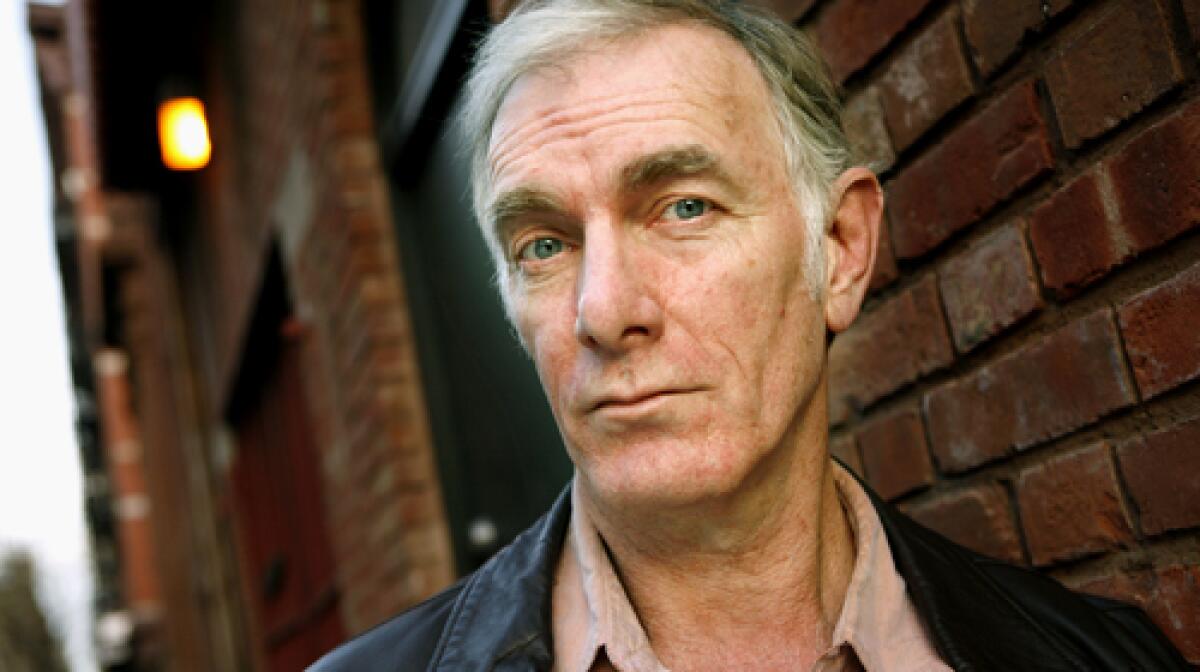John Sayles, novelist, seeks a binding agreement

Reporting from New York — For 40 minutes last month he held them spellbound, reading about America in 1898. John Sayles didn’t just give the crowd a taste of his new novel, “Some Time in the Sun” -- he performed a comedy about tabloid newsboys in New York, playing 26 characters with thick, period accents.
“WAR!” Sayles boomed in the voice of a 13-year-old newsie thrilled (“Trilled!”) that the Spanish-American War had boosted his daily street sales: “Remember the . . . Maine! Jeez, the way they played it out -- Day 1, the ship blows up. Day 2, who blew the ship up? Day 3, we think we know. Day 4, we sent down our experts!”
When it was over, the audience at City University of New York’s Gotham Center gave Sayles an ovation. But then he was humbled by a question from a woman in the front row: When would the book be out?
“I’ve been done with it for six or seven months, and it’s out to five or six publishers,” he said quietly. “But we haven’t had any bites yet.”
John Sayles, Oscar-nominated creator of “Return of the Secaucus 7,” “Lone Star,” “Matewan” and other movies, is having trouble getting a book deal.
The situation is almost entirely traceable to the publishing industry’s economic woes, and it’s raising eyebrows, because Sayles was an accomplished fiction writer long before he made his first film. Weighing in at a whopping 1,000 typed pages, “Some Time in the Sun” is his first novel since 1990’s “Los Gusanos.”
“This is really astonishing,” says Ron Hogan, senior editor of Galleycat.com, a website devoted to publishing news. “I mean, this is John Sayles! You’d think there would be some editor who’d be proud to say, ‘I brought the new John Sayles novel to this house.’ ”
Anthony Arnove, Sayles’ literary agent, sent the novel out on a first round of submissions last fall, and recently sent it to another group of editors. His goal is to land a deal with a deep-pockets publisher who can promote the sprawling, epic tale about racism and the dawn of U.S. imperialism.
Sayles’ 1977 novel, “Union Dues,” was nominated for the National Book Award and the National Book Critics Circle Award. “The Anarchists’ Convention,” his comic short story about aging Jewish lefties, has become an American classic.
But that’s ancient history in the publishing world, where an industry-wide deep freeze is getting colder by the day. The kind of deal Sayles might have landed several years ago -- when publishers might have taken on his new book for the prestige factor, or a sense that the economic gamble could be worth it -- is more difficult now.
It’s a jittery moment for writers and publishers, as sales plunge (down 4.2% in the first quarter of 2009) and the big houses lay off swarms of veteran editors. As the economic collapse continues, a novel like “Some Time in the Sun” becomes an increasingly harder sell.
“When I went out with the book last fall, one of the editors I hoped would express interest did so -- but then he was laid off,” says Arnove, who conceded he may eventually have to shop the book to smaller houses. “There’s a feeling that the old model isn’t working. And I think serious intellectual historical fiction will have a much harder time finding the home it deserves.”
Sales records matter more than ever, and some publishers are reluctant to take chances on writers such as Sayles, 58, whose previous books got rave reviews but were never bestsellers. The real challenge in selling a quality title now is not getting an editor to say yes, but overcoming the many ways a skeptical house can say no.
Sayles, who has spent three decades fighting similar battles in the indie film world, seems to shrug it off. As he chats about the new novel in his Hoboken, N.J., office, he sounds chagrined but also apologetic.
“I write a book every 15 years, and by the time I have another one done, I really don’t know anybody in the business,” he says. “It’s just not my world.” When he finished “Some Time in the Sun” -- of which he’s immensely proud -- he had no illusions: “There’s no way a publisher is going to be influenced just by somebody mentioning my name. They’ll check out the numbers of the latest title.”
A tall, muscular man with graying hair, Sayles received a flurry of rejections before signing a deal for his first novel, 1975’s “Pride of the Bimbos.” He sold “Los Gusanos” to HarperCollins without an agent. His most recent collection of stories, “Dillinger in Hollywood,” was published by Nation Books.
Luckily, his livelihood does not depend on publishing. When he’s not making his own films, he’s one of the most respected script doctors in Hollywood. Sayles is currently writing the pilot for an HBO series about the life of Red Hot Chili Peppers’ Anthony Kiedis and co-wrote the screenplay for “The Spiderwick Chronicles.” He’s worked on genre scripts such as “Piranha,” “Alligator” and “The Howling” and did rewrites for “Apollo 13” and “The Fugitive.”
Film work takes up so much of his time that Sayles’ two most recent novels were finished during the last two Writers Guild strikes. But “Some Time in the Sun” took shape almost as an afterthought.
A sprawling tale
Some 10 years ago he began to write a movie about America’s 1898 war with Spain over the Philippines, viewing it as an eerie precursor of U.S. military exploits in Vietnam. He was also fascinated by the last gasp of Reconstruction -- the era of virulent, post-Civil War racism. These two story lines fused and the script became unwieldy.
“There was no way in hell we were ever going to raise the money to make the film,” Sayles says. “I felt like I was pushing way too much stuff into a two-hour-and-20-minute format, and it would work better as a miniseries. But who gets to come in and say, ‘Oh, I want to make a 50-part miniseries about America at the turn of the century’?”
He finally decided the story should be a novel, which led to years of research and writing. “Some Time in the Sun” -- like his films -- blends vivid human portraits with historical events and brilliantly captures individual voices. In addition to his raucous newsboys, it spotlights African American and white soldiers fighting in the Philippines, fast-buck artists who help create the motion picture industry, and features cameos by Theodore Roosevelt, Mark Twain, William Randolph Hearst, Damon Runyon and other historical figures.
When he delivered the final draft to Arnove, Sayles assembled the novel in seven big binders and lugged them in shopping bags. His agent began reading on the subway home. Will other readers get the same chance?
“Very often when you write a screenplay, you realize that you’re kidding yourself,” Sayles says. “It’s a blueprint for a mansion that probably won’t get built, a mansion you’ll never get to live in.”
Now he wonders if “Some Time in the Sun” might suffer a similar fate.
“What’s a novel in this kind of climate?” he asks. “A hobby?”
More to Read
The biggest entertainment stories
Get our big stories about Hollywood, film, television, music, arts, culture and more right in your inbox as soon as they publish.
You may occasionally receive promotional content from the Los Angeles Times.










